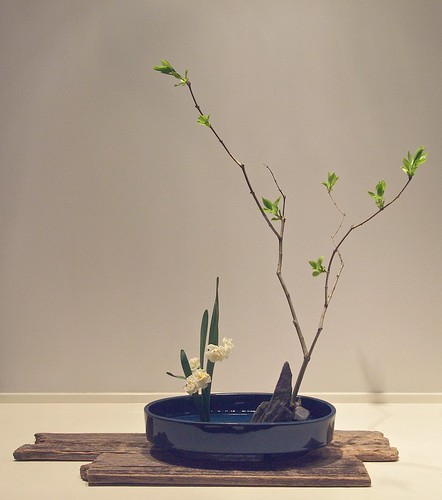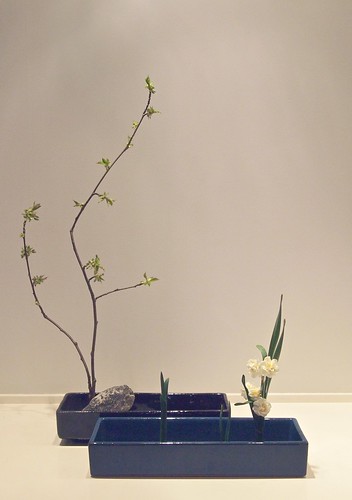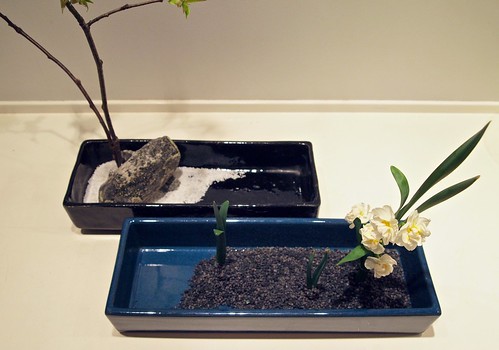Lilac (Syringa Vulgaris) and Narcissus 'Bridal crown'.
Guakugatte Futakabu-ike Suiriku-ike.
One of the most popular seika arrangements is the water and land style. This is also one of my favorites. The open water surface and the elegant lines makes it a peaceful and refreshing arrangement. Futakabu-ike means 'two root seika'. It consists of two separate groupings with an opening of water in-between, the main group usually consisting of shin and soe, and the supporting group usually consisting of hikae (tai in other schools).
There are two styles within futakabu-ike, gyodo-ike (fish path) and suiriku-ike (water and land). In gyodo-ike two groups of water material are placed so that they give the feeling of a path for the fish to swim through. In suiriku-ike, water plants are placed in a group closer to the front, and land material in a group at the back of the container. A mountain shaped stone is placed in front of the land grouping. This gives the impression of looking from a low angel across the pond to the mountains and trees on the other side.
The idea of this arrangement is to highlight the contrast between the two kinds of materials, arranging them to show their respective character. The water plants are considered in (yin) and the land materials are yo (yang).
Since this is a spring arrangement the flowers are placed low, in-between the leaves. Had it been later in the summertime the flowers would have grown higher, stretching up over the leaves.
Water and land arrangements are sometimes made with two containers. It gives a good depth, with the container in the front representing the water and the one in the background representing land. A nice and elegant detail is the sand at the bottom of the containers - white sand in the land container in sharp contrast to the black sand depicting the seabed.
Guakugatte Futakabu-ike Suiriku-ike.
One of the most popular seika arrangements is the water and land style. This is also one of my favorites. The open water surface and the elegant lines makes it a peaceful and refreshing arrangement. Futakabu-ike means 'two root seika'. It consists of two separate groupings with an opening of water in-between, the main group usually consisting of shin and soe, and the supporting group usually consisting of hikae (tai in other schools).
There are two styles within futakabu-ike, gyodo-ike (fish path) and suiriku-ike (water and land). In gyodo-ike two groups of water material are placed so that they give the feeling of a path for the fish to swim through. In suiriku-ike, water plants are placed in a group closer to the front, and land material in a group at the back of the container. A mountain shaped stone is placed in front of the land grouping. This gives the impression of looking from a low angel across the pond to the mountains and trees on the other side.
The idea of this arrangement is to highlight the contrast between the two kinds of materials, arranging them to show their respective character. The water plants are considered in (yin) and the land materials are yo (yang).
Since this is a spring arrangement the flowers are placed low, in-between the leaves. Had it been later in the summertime the flowers would have grown higher, stretching up over the leaves.
Unknown branch and Narcissus 'Bridal crown'.
Futakabu-ike Suiriku-ike with two containers.
Futakabu-ike Suiriku-ike with two containers.
Water and land arrangements are sometimes made with two containers. It gives a good depth, with the container in the front representing the water and the one in the background representing land. A nice and elegant detail is the sand at the bottom of the containers - white sand in the land container in sharp contrast to the black sand depicting the seabed.
Birds view of white and black sand.















No comments:
Post a Comment